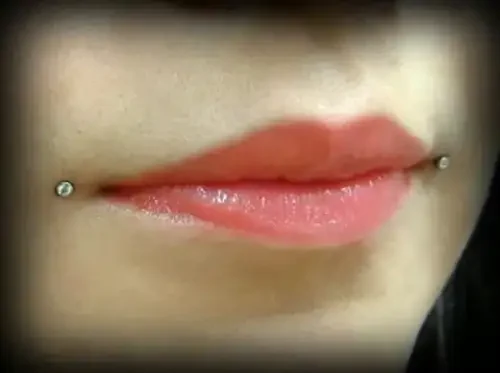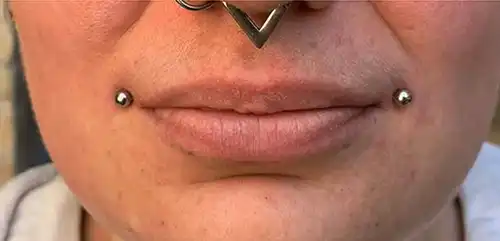Dahlia Piercing in Nairobi, Kenya
A Dahlia piercing is a unique and edgy lip piercing that involves two symmetrical piercings at the corners of the mouth. Named after the Dahlia flower for its placement, this piercing gives a striking effect that enhances the natural shape of the lips. Here are some key details and client tips for Dahlia piercings:
Dahlia Piercing
The piercing takes its name from the dahlia flower, which has petals that curve inward, similar to the curve of the piercing. It is typically done with a straight or curved barbell, and the healing process can take several weeks to a few months.
As with any piercing, it is important to find an experienced and reputable piercer who uses sterile equipment and follows proper aftercare procedures to minimize the risk of infection and ensure proper healing. It is also important to consider the potential risks and complications associated with the piercing, such as swelling, pain, scarring, and nerve damage.
Considerations before getting a Dahlia Piercing
Before getting a Dahlia piercing or any facial piercing, there are several important considerations to keep in mind. Taking the time to think through these factors can help you make an informed decision and ensure that the piercing is right for you:
- Professional Piercer: Choose a reputable and experienced professional piercer who is licensed and follows strict hygiene and safety practices. Ask for recommendations, read reviews, and visit the studio beforehand to assess its cleanliness and professionalism.
- Healing Time: Be prepared for a potentially lengthy healing process. Dahlia piercings, like other facial piercings, can take weeks to several months to fully heal. During this time, you’ll need to be diligent about aftercare to minimize complications.
- Pain Tolerance: Consider your pain tolerance level. Facial piercings, including Dahlia piercings, can be uncomfortable during and immediately after the procedure. If you have a low pain tolerance, discuss this with your piercer and be prepared for the sensation.
- Lifestyle and Occupation: Think about your daily activities and occupation. Certain jobs or activities may not be suitable for individuals with facial piercings due to hygiene or safety concerns. Some employers may also have policies against visible facial piercings.
- Jewelry Selection: Consider the type of jewelry you want to wear in your Dahlia piercings. Circular barbells and captive bead rings are common choices, but you’ll want to select jewelry that matches your personal style and comfort.
- Risk Factors: Understand the potential risks and complications associated with facial piercings. Infections, swelling, scarring, and jewelry migration are all possible issues. It’s essential to follow proper aftercare instructions to minimize these risks.
- Commitment to Aftercare: Be prepared to commit to a strict aftercare routine, which may include cleaning the piercings with saline solution, avoiding touching the jewelry with dirty hands, and refraining from oral activities (like kissing or oral sex) during the healing process.
- Allergies and Sensitivities: Inform your piercer of any allergies or sensitivities you have to certain metals or materials used in piercing jewelry. They can recommend hypoallergenic options to minimize the risk of allergic reactions.
- Consultation and Discussion: Have a thorough consultation with your piercer. Discuss your expectations, desired look, and any concerns you may have. Your piercer can assess whether you are a suitable candidate for Dahlia piercings and provide personalized advice.
- Future Plans: Consider your future plans, such as potential job changes or lifestyle adjustments. While Dahlia piercings can be removed if necessary, they may leave scars, so think about the long-term implications.
Dahlia Piercing Procedure
The Dahlia piercing procedure should always be performed by a professional piercer in a clean and sterile environment. Here’s a general outline of the steps involved in the Dahlia piercing procedure:
- Consultation: Before the procedure, you’ll have a consultation with the piercer. During this discussion, you can ask questions, discuss your expectations, choose the jewelry type and size, and address any concerns or allergies you may have.
- Preparation: Your piercer will sterilize their hands and wear disposable gloves to ensure aseptic conditions. They’ll also disinfect the area around your mouth where the piercings will be done.
- Marking: Your piercer will use a surgical marker to mark the exact placement of the Dahlia piercings. It’s crucial to achieve symmetry, so you and the piercer will check the markings in a mirror to ensure you’re satisfied with the placement.
- Piercing: Using a sterilized needle, your piercer will pierce through the marked spots on both sides of your mouth simultaneously. This is typically done quickly to minimize discomfort. Some pain, swelling, and bleeding are normal during and immediately after the procedure.
- Jewelry Insertion: Once the piercings are made, your piercer will insert the chosen jewelry, such as circular barbells or captive bead rings. They will secure the jewelry in place and make any necessary adjustments to ensure it sits comfortably.
- Aftercare Instructions: After the procedure, your piercer will provide you with detailed aftercare instructions. These instructions typically include cleaning the piercing with saline solution, avoiding touching the jewelry with dirty hands, refraining from oral activities during healing, and following a recommended schedule for changing or downsizing jewelry.
- Healing Process: Dahlia piercings can take several weeks to several months to heal fully. During this time, it’s crucial to follow the aftercare instructions diligently to minimize the risk of complications and promote proper healing.
- Follow-up Appointments: Your piercer may schedule follow-up appointments to monitor the healing process and make any necessary adjustments to the jewelry. They can also address any concerns or issues that may arise during the healing period.
Dahlia Piercing FAQ’s
Considerations before getting a Dahlia Piercing
Before getting a Dahlia piercing, it’s essential to consider several factors to ensure that you’re making an informed decision. Here are some key considerations:
- Pain Tolerance
– Sensitivity: The corners of the mouth can be sensitive. Consider your pain tolerance and whether you’re comfortable with the potential discomfort associated with the procedure. - Health and Medical Conditions
– Infections: If you have a history of keloids or are prone to infections, consult with your healthcare provider beforehand.
– Medical Conditions: Certain conditions (e.g., diabetes or blood clotting disorders) may affect healing. Be sure to discuss any medical issues with your piercer. - Lifestyle and Job Considerations
– Professional Environment: Consider whether your workplace or profession has restrictions on visible piercings.
– Active Lifestyle: If you participate in contact sports or activities that may put stress on your face, you might want to think about the implications of having a piercing in this area. - Aftercare Commitment
– Healing Process: Dahlia piercings typically take 3 to 4 months to heal fully. Be prepared to commit to a consistent aftercare routine, including cleaning and monitoring for signs of infection.
– Diet Changes: You may need to avoid certain foods (spicy, acidic) during the healing period, which may impact your eating habits. - Jewelry Options
– Initial Jewelry: Ensure you choose appropriate jewelry made from hypoallergenic materials (like titanium or surgical steel) for the initial healing phase.
– Long-Term Style: Consider the types of jewelry you may want to wear once the piercing has healed. - Placement and Aesthetic
– Symmetry: The aesthetic of the Dahlia piercing relies on symmetry; ensure that you are happy with the placement and how it complements your facial features.
– Personal Style: Reflect on whether this style fits your personal aesthetic and if you’ll still appreciate it in the long term. - Cost and Studio Reputation
– Budget: Consider the cost of the piercing, including aftercare products and jewelry changes.
– Research Studios: Choose a reputable piercing studio with positive reviews and proper health and safety standards. - Potential Risks
– Infection: As with any body piercing, there’s a risk of infection if proper aftercare is not followed.
– Rejection: In some cases, piercings can be rejected by the body, especially in areas with a lot of movement like the mouth.
By thoroughly considering these factors, you can make a well-informed decision about getting a Dahlia piercing and ensure a positive experience!
Pain and Healing for a Dahlia Piercing
When considering a Dahlia piercing, understanding the pain and healing process is crucial for setting realistic expectations. Here’s a detailed overview:
Pain Level
- Initial Pain: The pain level for a Dahlia piercing is generally considered moderate. The corners of the mouth are sensitive areas, and the sensation can vary depending on individual pain tolerance.
- Sensation: Many describe the feeling as a sharp pinch or pressure during the piercing process. Some clients may feel discomfort afterward, especially as the area begins to heal.
Post-Piercing Discomfort
- Swelling and Tenderness: It’s common to experience some swelling and tenderness in the first few days following the piercing. This can be more pronounced when eating, speaking, or moving your mouth.
- Pain Management: Over-the-counter pain relievers (such as ibuprofen) can help manage pain and reduce inflammation. Always follow the advice of your piercer or a healthcare provider regarding medication.
Healing Process
- Initial Healing Time: Dahlia piercings typically take 3 to 4 months to heal completely. However, full healing can take longer for some individuals, so patience is key.
- Stages of Healing:
– First Few Days: Expect mild swelling, redness, and tenderness. This is normal and should subside within a week.
– 2-4 Weeks: Swelling should decrease, but you may experience some discharge (clear or slightly yellow fluid) as the body heals.
– 4-8 Weeks: Most discomfort should lessen significantly. The piercing may still feel sensitive, but it should be manageable.
– After 8 Weeks: If properly cared for, the piercing should be well on its way to full healing. You may begin to change jewelry if desired.
Dahlia Piercing Aftercare
Proper aftercare is crucial for the healing of a Dahlia piercing and helps prevent complications like infections. Here are detailed aftercare instructions to follow after getting your Dahlia piercings:
General Aftercare Guidelines
- Cleaning Routine:
– Saline Solution: Clean the piercings twice a day using a saline solution. You can either purchase pre-made saline solution or make your own by mixing 1/4 teaspoon of non-iodized sea salt with 8 ounces of distilled or boiled (then cooled) water.
– Application: Soak a clean cotton ball or gauze pad in the saline solution and gently apply it to the piercings for about 5-10 minutes. This helps to reduce swelling and promote healing. - Avoiding Irritants:
– Harsh Products: Avoid using alcohol, hydrogen peroxide, or any antibacterial ointments, as these can irritate the piercing and delay healing.
– Fragrance and Dyes: Stay away from any products with fragrances or dyes around the mouth area, as these can cause irritation. - Oral Hygiene:
– Mouthwash: Rinse your mouth with an alcohol-free mouthwash after meals to keep the area clean. You can also use a saline rinse (mixing salt with water) for additional cleaning.
– Brushing Teeth: Be gentle when brushing your teeth to avoid irritating the piercing. You can use a soft-bristle toothbrush and be cautious around the pierced areas. - Dietary Considerations:
– Avoid Spicy and Acidic Foods: While your piercing is healing, steer clear of spicy, acidic, or very hot foods, as they can irritate the piercing and cause discomfort.
– Hydration: Stay hydrated, as this aids in the healing process. Drinking plenty of water also helps to keep your mouth clean. - Managing Swelling:
– Cold Compress: If you experience swelling in the initial days, apply a cold compress to the outside of your mouth (not directly on the piercing) for 10-15 minutes at a time. This can help reduce swelling and soothe discomfort. - Jewelry Care:
– Initial Jewelry: Avoid changing the jewelry until the piercing is fully healed (usually after 3-4 months). If you feel you need to change it sooner, consult with your piercer.
– Check for Movement: Ensure the jewelry is not too tight or too loose, as this can hinder healing. If it feels uncomfortable, consult your piercer.
Monitoring for Complications
- Signs of Infection: Keep an eye out for any excessive redness, increased swelling, warmth, or pus (especially green or yellow) around the piercings, as these can indicate an infection.
- Fever or Chills: If you experience fever or chills, seek medical attention, as this can indicate a systemic infection.
Follow-Up Care
- Piercer Check-In: Consider scheduling a follow-up appointment with your piercer after a few weeks to ensure that everything is healing correctly. They can offer advice on any concerns you may have.
Dahlia Piercing Jewelry
Choosing the right jewelry for your Dahlia piercing is crucial for both aesthetics and comfort during the healing process. Here’s a guide to the types of jewelry suitable for Dahlia piercings, along with tips for choosing and caring for it:
Initial Jewelry Options
- Labret Studs:
– Design: Labret studs are the most common initial jewelry for Dahlia piercings. They consist of a flat back and a decorative top.
– Material: Opt for hypoallergenic materials like surgical stainless steel, titanium, or niobium to minimize the risk of irritation or allergic reactions.
– Size: The post length should be appropriate to accommodate swelling. A typical length for initial jewelry is between 16G (1.2 mm) and 18G (1.0 mm) in thickness, with a length of 6-8 mm. - Microdermal Anchors (Optional):
– Consideration: Some people may opt for microdermal anchors for a more seamless look once the piercing is fully healed. These involve a small anchor placed under the skin, allowing for a variety of tops to be worn.
– Consultation: Discuss this option with our piercer to ensure it’s suitable for your anatomy and desired aesthetic.
Jewelry Styles for Healing
- Flat Back Labrets:
– Comfort: Flat backs are recommended as they sit comfortably against the skin and reduce the risk of irritation while healing.
– Low Profile: The low profile minimizes the chance of snagging on clothing or other surfaces. - Smooth or Rounded Ends:
– Less Irritation: Jewelry with smooth or rounded ends can help reduce irritation, especially during the initial healing phase. - Jewelry Styles After Healing
– Once your Dahlia piercings are fully healed (typically 3-4 months), you can explore a variety of jewelry styles, including: - Studs:
– Decorative Tops: You can switch to decorative labret studs with different designs, such as gemstones, unique shapes, or themed motifs. - Hoops:
– Captive Bead Rings: Small captive bead rings can be a stylish choice for Dahlia piercings, providing a different aesthetic while still being comfortable. - Dangle Earrings:
– Versatile Look: Dangle earrings that hang from the piercing can add an eye-catching element to your style. - Belly Rings:
– Creative Style: Some clients may choose to use belly rings in their Dahlia piercings for a unique and edgy look. Make sure they fit properly to avoid any discomfort.
Care for Jewelry
- Cleaning: Regularly clean your jewelry with saline solution or mild soap to prevent buildup and irritation.
- Avoid Switching Early: Resist the urge to change your jewelry too soon; wait until the piercing has fully healed to avoid complications.
- Consult a Professional: If you experience discomfort or notice any irritation after changing jewelry, Consult Our Piercer for advice on selecting appropriate options.
Choosing the right jewelry for your Dahlia piercing enhances your style while promoting healing and comfort. Always prioritize hypoallergenic materials and consult with your piercer to ensure the jewelry fits well and is appropriate for your healing stage. Enjoy expressing your unique style through your Dahlia piercings!
Cost of a Dahlia Piercing in Nairobi, Kenya
The cost of a Dahlia piercing can vary widely based on several factors, including the location of the piercing studio, the experience of the piercer, and the type of jewelry chosen. Here’s a general breakdown of what to expect regarding the cost:
General Cost Range
- Piercing Cost: Typically, the cost for a Dahlia piercing ranges from Ksh. 3,000 to Ksh. 5,000. This often includes the price of the initial jewelry.
- Jewelry: Depending on the material and design, jewelry can add an additional cost. Basic labret studs in surgical stainless steel or titanium usually range from Ksh. 500 to Ksh. 1,500. More elaborate or custom pieces can be more expensive.
Factors Influencing Cost
- Location:
– Urban vs. Rural: Piercing studios in urban areas or major cities tend to charge more due to higher overhead costs compared to those in rural locations. Rebel Inks Tattoos, Tattoo Removal, and Body Piercings Parlour is located in the heart of the Central Business Disrict (CBD) in Nairobi, Kenya, and is easily accessible to both locals and foreigners in the country.
– Reputation of the Studio: Established studios with a good reputation may charge higher prices due to their experience and quality of service. - Piercer’s Experience:
– Professional Fees: More experienced piercers may charge higher fees for their expertise, which can be worth it for the assurance of a professional job. At Rebel Inks Tattoos, Tattoo Removal, and Body Piercings Parlour we have experienced professionals who offer quality and premium services. - Type of Jewelry:
– Material Quality: Hypoallergenic materials such as titanium and high-quality surgical steel typically cost more than basic materials. Specialty or custom jewelry can significantly increase costs.
Additional Costs
- Aftercare Products: You may also want to budget for aftercare products, such as saline solutions or mild cleansers, which can cost around Ksh. 300 to Ksh. 1,000.
- Follow-Up Appointments: If needed, follow-up appointments for jewelry changes or check-ups might incur additional costs.
Dahlia Piercings Price Breakdown Table
Component / Service | Estimated Cost (KSh) | Details / Notes |
Dahlia piercings (procedure + basic jewelry) | 3,000 – 5,000 | Standard pricing |
Premium or hypoallergenic jewelry (titanium/niobium) | 500 – 1,000 | Optional for sensitive skin or aesthetic upgrades |
Aftercare kit (saline spray, instructions) | 300 – 800 | Important for healing; may be included or not |
Follow-up / downsizing visit post-healing | 200 – 500 | Adjust jewelry length as swelling subsides |
In summary, you can expect to pay between Ksh. 3,000 and Ksh. 5,000 for a Dahlia piercing, including basic jewelry. Always research local studios, read reviews, and prioritize a reputable piercer to ensure a safe and professional experience. Additionally, don’t hesitate to inquire about costs and what is included in the service during your consultation!
Possible side effects of Dahlia Piercing
Like any body piercing, a Dahlia piercing can come with potential side effects and complications. While many people experience a smooth healing process, it’s important to be aware of what could happen. Here are some possible side effects associated with Dahlia piercings:
Common Side Effects
- Swelling and Bruising:
– Normal Response: Mild swelling and bruising around the piercing site are common immediately after the procedure and can last for a few days. - Redness and Tenderness:
– Initial Healing: It’s normal for the area to appear slightly red and tender during the initial healing phase. This should improve within a week. - Discharge:
– Clear Fluid: Some clear or slightly yellow fluid may be produced during the healing process, which is a normal response as the body heals.
Possible Complications
- Infection:
– Signs: Look out for increased redness, warmth, swelling, or pus (especially yellow or green) around the piercing. An infection may require medical treatment.
– Prevention: Proper aftercare and hygiene can help minimize the risk of infection. - Keloids or Scarring:
– Skin Response: Some individuals may develop keloids (raised scars) at the piercing site, especially if they have a history of keloid formation.
– Management: Consult with a healthcare professional if you notice abnormal scarring. - Allergic Reactions:
– Material Sensitivity: Some people may experience allergic reactions to certain metals used in jewelry, such as nickel.
– Symptoms: Reactions can include itching, redness, or swelling. Switching to hypoallergenic materials (like titanium) can alleviate this. - Rejection:
– Piercing Migration: In some cases, the body may push the jewelry out, resulting in migration or rejection of the piercing. This is more common in surface piercings.
– Signs: If you notice the piercing looks more shallow or the jewelry is becoming visible on the surface of the skin, consult your piercer. - Nerve Damage:
– Rare Occurrence: Though rare, there is a risk of hitting a nerve during the piercing, which could lead to numbness, tingling, or loss of sensation in the area.
– Follow-Up: If you experience unusual sensations, consult your piercer or a healthcare professional. - Dental and Oral Issues:
– Oral Jewelry Risks: If the jewelry is not properly sized, it may irritate the gums or teeth. This can lead to receding gums or tooth wear.
– Careful Monitoring: Pay attention to any discomfort while eating or talking and consult your dentist if you experience issues.
While many individuals enjoy their Dahlia piercings without significant complications, it’s essential to be aware of the potential side effects. Practicing proper aftercare, monitoring the piercing for any unusual symptoms, and consulting professionals as needed can help ensure a positive experience. If you have any concerns about your piercing, don’t hesitate to reach out to your piercer or a healthcare professional for guidance.
Get In Touch
For more information on the list above and any other special services,please call or come in for free consultation
Testimonials
After he pierced my industrial piercing and seeing his amazing work, I feel even more excited about getting my tattoo with him in January. I’m really looking forward to it!
I am extremely happy with my new 'Safari' tattoo from Eric at Rebel Inks! The quality of the artwork is fantastic. Eric is a true professional and an amazing artist.
The preparation and design process was thorough and collaborative. He was very patient with my specific requests, including making sure all the elements, which hold personal meaning, were perfect.
The service was friendly and highly professional from start to finish. Despite the 8-hour session, Eric was a pleasant person to spend the time with.
The aftercare guidance and follow-up have been excellent and careful, which has made the healing process easy and better than expected.
I highly recommend Eric for anyone looking for a thoughtful, talented, and caring tattoo artist.
I recommend them 💯
I would definitely recommend if you’re thinking of getting a piercing!
The staff were super friendly, explained everything clearly, and made me feel so at ease. They answered all my nervous questions (and I had many questions),
They walked me through the whole process, gave detailed aftercare instructions, and even followed up afterward to check how I was healing 🫶
Clean, professional, and full of good vibes.
Would 100% recommend . Definitely making a second trip here.
This was the second tattoo I got and I wish I could have come to Eric for my first one! He gave me really great after-care directions for the tattoo as well as a little jar of his own Vaseline-type stuff to put over my tattoo while it was healing! He even put second skin over my tattoo so that I didn’t have to worry about it for the first few days. Now THAT’S good service. My first tattoo artist didn’t do none of that lol.
After the session Eric didn’t rush me and my friend out, he chatted with us and even when he found out I was an artist too— really encouraged me to keep creating and to find a community of artists to support me. I almost cried because I’ve had such a hard time with my own art the past couple of years, it meant so much to me to have a fellow very talented artist say that to me. 🤍🤍🤍
Eric you’re amazing, don’t ever stop creating and just know you’ve impacted lives all over the world!🫶🏻 thanks so much for everything!!
From the moment I walked in, Eric was professional, welcoming, and attentive. He made sure I was comfortable throughout, provided everything I needed, and explained every step of the process. The tattooing itself was unbelievably smooth - I genuinely felt no pain compared to my previous tattoos over the last 22 years.
Eric also gave me excellent aftercare guidance and products, and thanks to that, my tattoo healed beautifully. The attention to detail, precision, and shading are absolutely stunning. This is hands-down the best tattoo I've ever had, and I will be flying back to Nairobi for any future ink.
If you want incredible art, a professional experience, and a talented artist who truly cares about his clients, Rebel Ink is the place to go!
From start to finish, the service was exceptional. The piercer was professional, knowledgeable, and made me feel completely comfortable. The cleanliness of the place was above and beyond — everything was spotless and hygienic, which really put me at ease. Highly recommend for anyone considering a piercing!
Shout out to Eric😘
We ended up changing the jewelry three times to ensure I had the best fit and avoided any signs of rejection, and he always listened to my suggestions as a client, which I really appreciated. Now, three months in, my piercing is healing beautifully, with no sign of rejection. Highly recommend for anyone who values a piercer who cares about your comfort and healing journey!
What stood out the most was the aftercare Eric checked in with me even three weeks later to see how the tattoo was healing. That kind of follow-up shows how much he truly cares about his work and his clients.
I’m very satisfied and will definitely be coming back for my next piece. Highly recommend!
The piercing wasn't as painful as I had thought and the process was quick and satisfactory. I love it!!!
The piercing is healing well thanks to the aftercare instructions and follow-up. I would highly recommend Rebel Inks
Eric also did a belly button piercing for a friend, guiding her through the process, doing the piercing and then explaining the after care to her.
The shop is on the 3rd floor, with the entrance to the stairs near an alleyway on the left. The shop is perfect size, clean, and attractive looking. The mural is pretty dope.
Thank you for the amazing service! 🔥👅✨
I got piercibgs there and the process was really good. My biggest concern was hygiene but that wasn't an issue at all, they use new needles and they sanitize them.
The service itself was also welcoming.
I was informes of everything i needed to know beforehand.
10/10 would recommend!
Eric was so calm and patient with my almost 2 year old lady. It was such a clean and hygienic process. We will definitely be back for our second rounds of piercings and maybe even another tattoo!
They assess the area before any art and advise one accordingly. They also give one post clean up process and also do a check up after the body art projects. Overall, I loved my experience and I’m hooked. 👍
Will definitely come back next time I’m in town 🙂
He listened to what I actually wanted and made sure he could fit in the time before I flew back home.
The shop is clean & private and is easy enough to find.
Eric has even checked in a couple of times since to make sure all is good.
I would totally recommend Eric! I absolutely love my Elephants!
I had a very easy healing period and always follow up from Eric to check on my progress...I would highly recommend if you are a first timer because from my experience all went very well and attention to detail
Thank you for a good job and looking forward to send all my friends your way
And all the best with the new year 2025!
From the moment I walked in, the staff was super friendly and made me feel at ease. The studio had a clean, professional atmosphere, which immediately put me at ease. My piercer was incredibly skilled and explained every step of the process, ensuring I was comfortable the entire time. The piercing was quick and practically painless, and the aftercare instructions were clear and easy to follow. I can tell they really care about the health and safety of their clients.
Overall, a fantastic experience—I highly recommend Rebel Inks and Tattoos for anyone looking to get pierced or tattooed!
They do follow up after their services
Eric's Studio isn’t just a place to get a tattoo—it’s an experience. The combination of professionalism, artistic talent, and a welcoming environment makes it a standout destination for anyone considering a tattoo.
I highly recommend Eric’s Studio to both first-timers and seasoned tattoo enthusiasts. If you’re looking for a high-quality tattoo and an enjoyable experience, this is the place to go.
I would definitely recommend their services again and again
Thank you Rebel Ink
My piercings are healing ❤️🩹 well
I would 💯 recommend
I will definitely come back for more .
Two, all the equipments he used for the piercings were new and/or sterilised.
Three, the parlour itself was very clean and was up to par with the hygiene standards.
Four, Eric provided effective aftercare instructions, making sure I knew exactly how to take care of my new piercings and he kept in touch and continues to do so, to check on the healing progress.
I highly highly highly recommend this place!!!
Would definitely recommend them to friends and go back for other piercings
Not only was the piercing process smooth, but he also provided thorough aftercare instructions, making sure I knew exactly how to take care of my new piercings. What really impressed me was that he keeps in touch to check on how the healing is progressing – a sign of true care for his clients.
The shop maintains a high standard of hygiene, and the atmosphere is welcoming and comfortable, which really added to the positive experience. I highly recommend this place to anyone looking for a professional and caring experience. I’ll definitely be coming back for any future piercings!
My appreciation for the excellent customer service I received. The follow-ups were prompt, and I truly appreciated the gentleness and professionalism throughout. Thank you!"
"Looking for professional eyebrow microshading removal? Look no further!"
The customer care is top tier 👌🏾👌🏾.
Wonderful place to get tattoos and piercings. 💯💯
Eric goes ahead to follow up on his clients progress and gives good advice each time I reach out to him.
I would recommend Reble tattoos anytime.
Good job bro we really appreciate.
Ohh and the price is very fair.
The environment was clean , procedure was sterile and the jewelry used are of the best quality.
He followed up with me during the healing process, he educated me on what I needed to do for my aftercare.
Eric is confident, skilled , experienced and the best piercer. Highly recommend Rebel inks.✨
Definitely recommend!
Great experience.
Eric definitely know what he is doing .
I got exactly what I wanted 2 tiny tats on the same finger .
He was kind and patient throughout the session.
Healing process has been good .
Aftercare services were given and regular checkups on the healing process were done.
I would 💯recommend.
Eric gave me the best reception as it was my first time there,and made me trust him all the way. I appreciate good services.
There services are also affordable not to forget 😊.
He was also invested in the aftercare and would ensure I follow the do's and don'ts in taking care of the tattoo and ensuring proper healing and maximum ink retention.
Would highly recommend Rebel Inks Tattoos.
Rebel Inks Tattoo offer the best,affordable and quality tattoo removal services.If you have unwanted ink,choose Rebel Inks Tattoo,they're the best of the best and the professionalism is a top notch.They ensure you're free from unwanted ink with their Laser Tattoo Removal Technology...
I did a Laser Tattoo Removal with them and i can attest they're the best....
Kudos Eric...
I highly recommend.
It was a generally good experience with good hygiene during the piercing process and has been a smooth healing process.... 10/10
tips. Highly recommend 👍🏽
100% recommendable.
I was particularly impressed with Eric's attention to hygiene. He thoroughly cleaned the room before I entered, sanitized all of the equipment he would be using, and changed gloves between each ear. This level of cleanliness gave me great confidence in his professionalism.
Eric's commitment to customer service did not end on the day of the piercing. He followed up with me regularly throughout the healing process to ensure that I was following the aftercare instructions and that my earlobes were healing properly.
I highly recommend Rebel Inks to anyone in Nairobi who is considering getting a piercing. Eric is a highly skilled and experienced piercer who takes great pride in his work.
So I Check all the boxes below and more:
Customer Care: ✔️
Professionalism : ✔️
Cleanliness ✔️
Price: ✔️
After care service ✔️
Thanks and good job, Eric
The place is neat and clean and the equipments he used were also fine standards. Really appreciate his following up with me on the healing 🤗
I WOULD HIGHLY RECOMMEND THEIR SERVICES to everyone. Actually what you see on their website is EXACTLY what you will get. Keep up the good work Rebel inks Tattoos.
The infection is now gone. I would definitely recommend!
Can recommend this place totally and would go back there anytime!
Thanks!
OUR LOCATION
Areas We Serve
NAIROBI
KIAMBU
KAJIADO
MACHAKOS


















































































































































































































